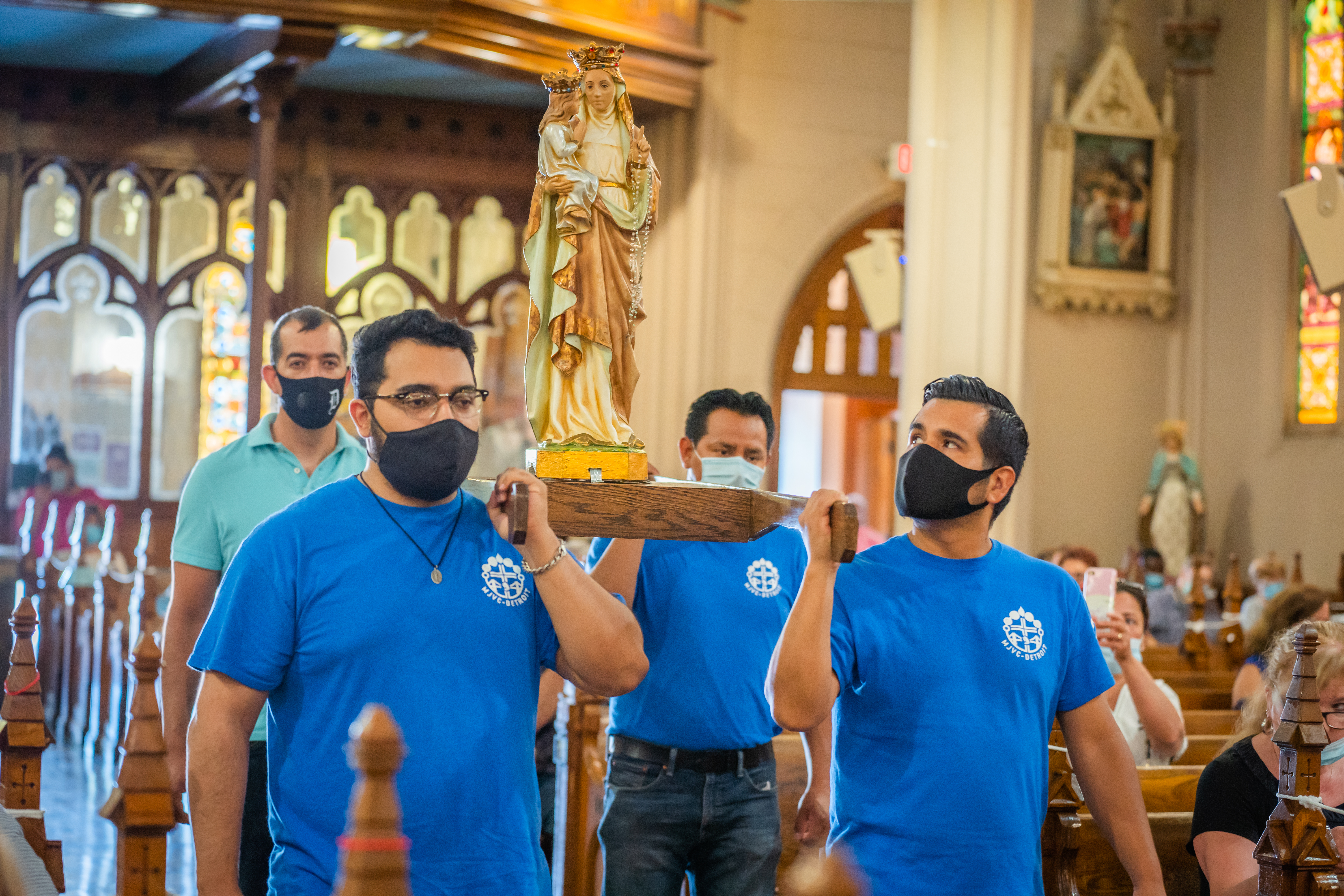Faithful celebrate the ‘Church’s grandparents’ with special Mass and traditional Breton hymn at Detroit’s newest basilica, oldest parish
DETROIT — On Sunday, July 26, the faithful in the Archdiocese of Detroit celebrated the feast day of Ste. Anne, the city’s patroness, and her husband, Joachim.
Although Ste. Anne’s presence in the city dates to its founding in 1701, devotion to the grandmother of Christ has surged in recent years, thanks in part to Pope Francis naming Ste. Anne Church a minor basilica earlier this year, and numerous answered prayers for pregnancies and other intentions during the annual novena to Ste. Anne leading up to her feast day.
“We give God thanks and we praise Ste. Anne for her power as an advocate, an intercessor,” Archbishop Allen H. Vigneron said in his homily during the first feast day Mass at the newly named Basilica of Ste. Anne. “The wide experience in the lives of the faithful is to look to Ste. Anne as a reliable intercessor.”

The archbishop recalled the first time he celebrated the feast of Ste. Anne and St. Joachim at the southwest Detroit parish; he was asked to give a blessing to a woman who couldn’t conceive. The following year, she returned to the feast day with twins. This, the archbishop said, “is just one of the many testaments to the fact that Ste. Anne’s intercession is powerful and it still works — she is our grandmother.”
“They are whom Sirach spoke about: those Godly men and women who because of their covenant with God have a posterity that endures forever,” Archbishop Vigneron said. “In some sense, that is you and me. We are sisters and brothers of Jesus Christ. Mary is our mother. So, in a real sense, Ste. Anne is our grandmother in the faith, Joachim our grandfather.
“How blessed we are to be their progeny; how blessed they are that they have had millions and millions of descendants,” the archbishop said.
As part of the 2020 celebration, Joe Balistreri, director of music for the archdiocese and the Cathedral of the Most Blessed Sacrament, and Susan Lindquist, director of the Cathedral Choir Academy, transcribed a 19th century hymn in honor of Ste. Anne from the Breton language into an English translation that was performed during the feast day Mass at the Basilica of Ste. Anne and in parishes across the archdiocese.

Breton is spoken in Brittany, a cultural region in western France where there is a particularly strong devotion to Ste. Anne. The hymn, “O Anna Mamm Mari,” was written more than a hundred years ago by a priest or monk from the Shrine of Saint Anne d'Auray in Brittany.
“Some of this (devotion) has made its way to Canada — think of the shrine of St. Anne de Beaupre in Quebec,” one of the oldest Catholic churches in North America, Balistreri said. From there, he said, the devotion trickled down to the French-founded Detroit.
Balistreri worked alongside a linguist to translate a French version of the hymn to English, and from there Balistreri did his own poetic translation while maintaining the hymn’s original melody line. Ultimately, he opted to keep one line of the original Breton in the song, the title: “O Anna Mamm Mari.”
Listen to the hymn
Balistreri said each year leading up to the feast of Ste. Anne, it seems as if a new musical treasure honoring Ste. Anne is discovered or composed.
“These little traditions pop up all over the place,” Balistreri said. “You find that in a lot of the lives of saints; every culture and every community has their own particular little tradition, and those things eventually mix and spread and help form the greater culture of devotion.”
For Balistreri, music as a form of devotion and prayer is an important part of the Catholic faith and tradition.
“Music expresses the sentiments of our hearts in a way that gives an entire other dimension to the proclamation text,” Balistreri said. “For example, I can pray the Hail Mary or I can sing the Avé Maria, as they are both the same prayer, but there is a whole different depth of fervor when we put those words to song.”

Devotion to the saints is an expression of the human need for heartfelt emotion, Balistreri said. Sometimes, he said, people are unable to express their prayer in words, which is where the saints come in.
“In a litany or a series of exhortations, we invoke the saints, we call on the saints and we beg them for their intercession, for they know how to pray for what our hearts need better than we do,” Balistreri said.
Balistreri hopes the new hymn contributes to the growing love and devotion to Ste. Anne throughout southeast Michigan.
“My prayer and my hope are that it continues to increase our devotion to Ste. Anne, who really is the lynchpin of the entire founding of our city,” he said.










